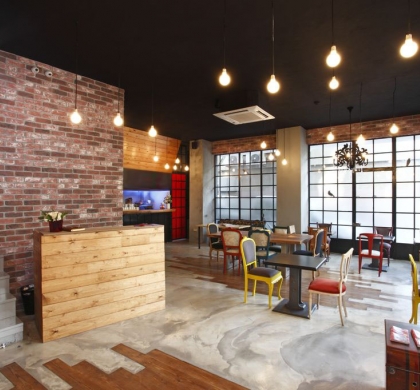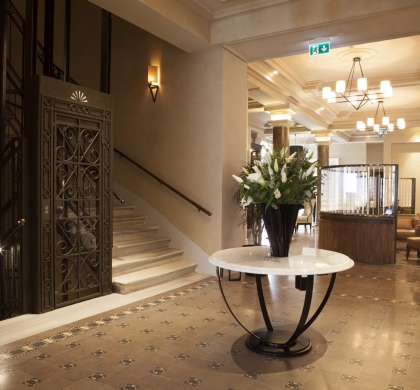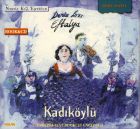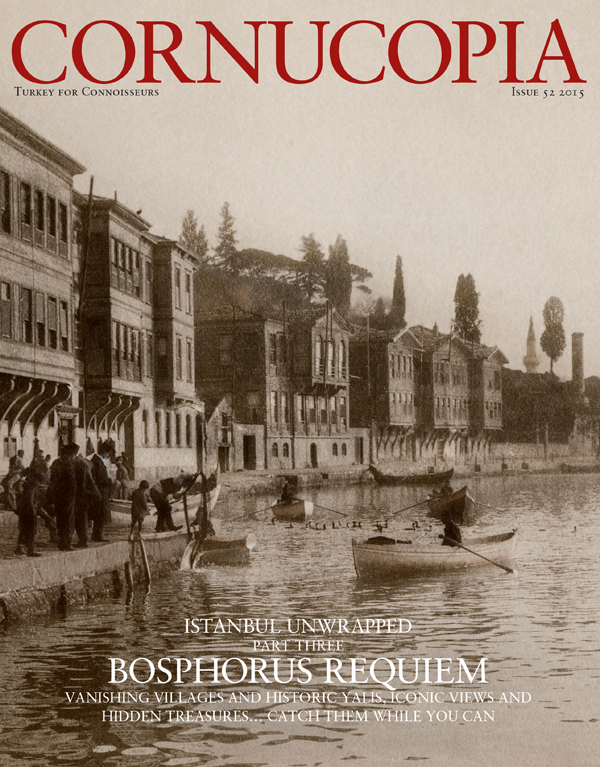Buy or gift a stand-alone digital subscription and get unlimited access to dozens of back issues for just £18.99 / $18.99 a year.
Please register at www.exacteditions.com/digital/cornucopia with your subscriber account number or contact subscriptions@cornucopia.net
Buy a digital subscription Go to the Digital EditionAn exciting new spirit of creativity is flourishing in Yeldeğirmeni – once a place of windmills and construction workers. But will this vibrant neighbourhood of Kadiköy be able to maintain its delicate balance of old and new? Katie Nadworny reports. Photographs by Monica Fritz
At first sight, Yeldeğirmeni is a deceptive place. With its elegant old buildings rubbing shoulders with more recent nondescript apartments, this neighbourhood of Kadıköy seems like any other residential Asian-side enclave. But it is actually the centre of a new world, where artistic creativity is being nourished and celebrated.The residential streets form a rough grid, with each narrow road sloping down to the Kadıköy docks. Divided cleanly by the long, busy artery of Söğütlüçeşme Caddesi from the districts of Bahariye and Moda, on the other side of Kadıköy, Yeldeğirmeni can initially seem like an island of local colour, more rooted in its residents than cosmopolitan Moda, with its yacht club and esplanade of leafy clifftop cafés. Karakolhane Caddesi is the central branch of Yeldeğirmeni’s streets, where traditional bakkals and barbers’ shops have only just begun to share space with bars and coffee shops, like Bizim Kitap Kafe, whose hallways, brimming with books, open up to a garden hidden away from the busy road.
Yeldeğirmeni is a place where the texture of previous years hasn’t quite been sanded away; instead, stylish cafés and atölyes are tucked in beside laundromats with dry-cleaning hanging in the windows. The bright murals of the annual Mural Istanbul festival liven up unexpected corners, bursting over dusty parking lots or the sides of hotels. Historically, Jews and Armenians lived in this neighbourhood, which dates back to the 15th century, and it’s still possible to catch the shadows of those communities in a tucked-away synagogue or orphanage.
During the Ottoman era, this neighbourhood was dotted with flour mills that supplied bread to the sultan’s palace and the surrounding area. The windmills not only lend the neighbourhood its name but also explain the continued abundance, to this day, of bakeries. Later, at the beginning of the 20th century, Yeldeğirmeni housed the workers constructing the elegant Haydarpaşa railway station. Many of the station’s engineers lived in the Valpreda Apartment (also known as the Italian Apartment), built in 1909 in the Art Nouveau style. This is still a residential building, and throughout the area there are deliberate echoes of this period – Garda Café, for example, is designed as a facsimile of Haydarpaşa. Elaborate wall paintings wrap around Garda’s interior, and it’s easy to imagine that you can hear the soft whistle of an incoming train, on its way to whisk you across Anatolia.
The blooming of Yeldeğirmeni is part of a larger cultural shift away from Beyoğlu and towards the Asian shore, thanks in large part to the centring of political unrest around Taksim Square. With the Beyoğlu district already ripe for redevelopment and plagued by ever-rising rents, the artistic community slowly started to drift away. After the Gezi Park protests – sparked by, among many things, the mindless crush of development – filled the area with nightly tear gas in 2013, the exodus quickened. The İstiklâl bombing in 2016 hastened the trend. As artists fled Beyoğlu, they slowly began to find their groove in the innovative cultural spaces of comparatively laid-back Kadıköy. While traditional greengrocers and cobblers still linger, and men sit in chairs smoking cigarettes and reading newspapers on the streets, energetic new bohemian spaces are transforming the fabric of the neighbourhood.
“There’s not much alternative stuff happening on the other side any more,” says Nuray Kerkük, the owner of Hangart. With her chestnut hair pulled back in a loose ponytail, she smiles and chats with regulars and first-time visitors. Her café-cum-performance space serves as a venue for concerts, exhibitions, readings, workshops and other creative projects. Drawn by both the convenience (she lives in the area) and the alternative artistic community already rooted in Yeldeğirmeni, Kerkük opened Hangart in 2015. The venue features jazz, classical and alternative music – mostly music that appeals to Kerkük herself, including that of local favourites like the bands Country for Syria and Flapper Swing. During the day, sunshine spills into the quiet mint-green café space as locals linger over çay. At night, the venue fills with people eager to hear the live music. Though Hangart doesn’t serve alcohol, Kerkük laughingly admits she will occasionally slip a glass of wine to her regular patrons during concerts. They are all part of her extended Yeldeğirmeni family.
Circuit is another European transplant, only recently relocated from its original haunt in Çukurcuma (Beyoğlu’s antiques district) to a crisp new space in Yeldeğirmeni. Having started as a vintage clothing store with an emphasis on sustainability, it has kept the emphasis but lost the clothes. Now Circuit hosts classes for everything from watercolour painting and yoga to permaculture, while also functioning as an alternative gallery space for local artists. “We were recommended Yeldeğirmeni as a suitable and supportive neighbourhood for our organisation,” says Jessica Sim, Circuit’s co-director, a vivacious Canadian in her twenties whose enthusiasm is palpable. The move has changed Circuit’s mission as it adapts to its new neighbourhood. “To expand our reach, in particular to our more immediate neighbours, we are working to widen our community of collaborators; for example, by hosting bazaars and exhibitions that feature local artists and crafts-makers, and by bringing in new instructors for classes and workshops.”
Wandering up Uzun Hafız Sokak past Müdavim Lokantası, a modern cafeteria with a deliberately retro feeling, brings you to Nayn, a café whose charcoal-grey walls are filled with brightly coloured art. The owner, Şafak Pala (below right), founded Nayn two-and-a-half years ago after a stint working at Galata Café in Beyoğlu. Finding there wasn’t enough work on the European side and sensing the trend towards Asia, he decided to open his own café. “Everyone is moving back to Kadıköy,” he says. In August, Nayn was one of the three venues hosting the 100 Days of Drawing exhibition, an illustration project by a local artist, Merve Midilli. It is multipurpose creative spaces like this that are bringing a communal, artistic feel to Yeldeğirmeni.
Komşu Kafe is a pay-what-you-will collective that hosts themed culinary nights. While people nosh on the nightly selection of Syrian, Italian or Bosnian cuisine, the district’s traditional men-only cafés remain just across the street, providing an echo of the past. Arthere’s café is a footnote to its main mission. Founded by the French-Syrian photographer Omar Berakdar as a space run by artists for artists, Arthere comprises a performance space, gallery and clubhouse.
It hosts films, installations, performances, workshops and exhibitions, and artists including Syrians and other arrivals come together here to collaborate and share their work. The walls are covered with the art of the collective’s members – all for sale – and home-made swings hang from the ceiling. The venue Art/ist seems on the surface like a more straightforward café, but it too combines its café with a workshop and exhibition space. It was founded by the interior designer Özge Taştan early in the summer of 2017, when she sensed that this was fertile ground for launching a multi-tentacled creative project. As one of Yeldeğirmeni’s newer spaces, it is both full of potential and indicative of the area’s atmosphere. This is the place where creative Istanbullus can start something new.
Local support is key to all of this creative blossoming. “Like other central and historic neighbourhoods in Istanbul, Yeldeğirmeni is home to diverse groups of people,” says Jessica Sim, “and gentrification is an ever more important topic.” But, as she points out, Kadıköy is clearly in favour of artistic and creative initiatives: it has a record of supporting street art, and this year it organised the first municipal Environmental Festival.
Even as creative outlets shift from Beyoğlu to Kadıköy, much of this exciting artistic scene is local and home-grown, and great efforts are being made to keep the vibe of the neighbourhood true to its long-time residents, as well as its new arrivals. It’s all helping to make Yeldeğirmeni the new centre of Istanbul’s creative community. Kadıköy’s moment is now.
Today a ghost town in the middle of nowhere, a thousand years ago Ani was a bustling commercial city where East and West converged. By Robert Ousterhout. Photographs by Brian McKee
No wonder Aphrodisias was the Emperor Augustus’s favourite city in Asia. Famed for its exquisite sculpture and unsullied surroundings, for Patricia Daunt it is the most beautiful site in the classical world
In a chilly spring the apricot trees of Cappadocia were frothing with white blossom. By early summer the boughs would be heavy with fruit, to be eaten fresh from the branch, dried in the sun – or made into conserves like bottled sunshine for the cold winter months.
After a road trip like no other, taking in many of the best of Turkey’s burgeoning wineries, Kevin Gould and the Cornucopia tasting panel raise a glass (or several) and recommend the best of an impressive bunch
Peter Alford Andrews and his late wife, Mügül, set out to catalogue the traditional yurt – the ultimate portable dwelling. It became their life’s work.



Deniz Kizi Eftalya, chanteuse


Cornucopia works in partnership with the digital publishing platform Exact Editions to offer individual and institutional subscribers unlimited access to a searchable archive of fascinating back issues and every newly published issue. The digital edition of Cornucopia is available cross-platform on web, iOS and Android and offers a comprehensive search function, allowing the title’s cultural content to be delved into at the touch of a button.
Digital Subscription: £18.99 / $18.99 (1 year)
Subscribe now